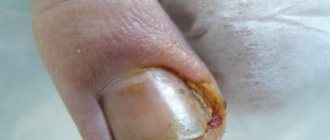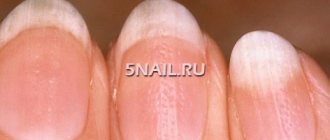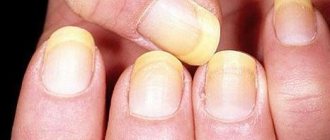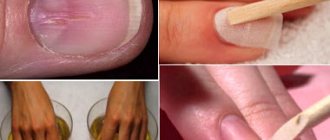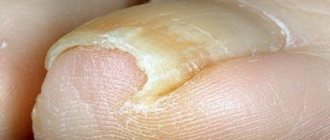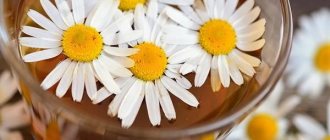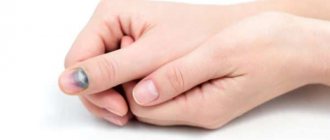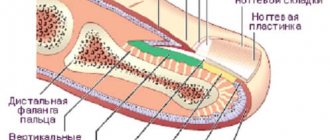Causes of fingernail fungus
A disease such as fingernail fungus (scientifically called onychomycosis) is not uncommon and is found everywhere throughout the globe. The disease is infectious in origin and loves high humidity and temperature. There are several ways of infection:
- Household way - when using other people's/shared personal care items: combs, slippers, manicure accessories, towels.
- Failure to comply with personal hygiene rules.
- A common route of transmission is public institutions: saunas, nail salons, sports complexes, swimming pools.
- When in contact with animals, both stray and domestic dogs and cats are susceptible to this disease. When walking outside, they can pick up the disease from another sick animal, or while in an infected environment, which is a source of infection.
The causes of the disease are infection with fungal bacteria through contact with infected surfaces touched by human hands. It is also possible that the disease develops on the hands after interacting with one’s own infected toenails.
It should be noted that women get the fungus more often than men, since it is women who usually bear the responsibilities of housework, as a result of which housewives are more likely to come into contact with water and household chemicals, which provokes a higher likelihood of developing onychomycosis.
Signs and symptoms of fingernail fungus
This disease manifests itself gradually, however, early manifestations of onychomycosis can be noticed on your own and you can consult a specialist to begin treating fingernail fungus. It occurs in three stages:
- Fungal infection (initial stage)
— There are no visible indicators of the disease.
-Barely visible grooves and spots appear on the nail plate.
- Middle stage
— Over time, there is a change in color from natural light pink to: yellow, gray, green, black, white.
- The natural healthy shine is lost.
- A barely noticeable deformation of the plate shape appears.
- Launched stage:
- The nail changes significantly.
— The nail thickens and falls off the finger.
- Delamination.
In addition to this, itching, increased sensitivity and a lowered pain threshold of the skin next to the nail plate appear. These symptoms make you feel ashamed of yourself, try to hide, disguise your illness, provoke the emergence of complexes and self-doubt, which generally reduces the quality of life. A person avoids shaking hands and tries to hide his hands. This is what fungus looks like on your hands.
Typically, adults are susceptible to onychomycosis; this disease in children is very rare. Before you begin to treat the fungus, you should determine the causes of the disease. The course of treatment will depend on the degree of damage to the nail plate. As mentioned above, the disease manifests itself against the background of reduced immunity, and there are also risk factors that make the appearance of mycosis of the fingernails more likely:
- Exacerbation of chronic diseases.
- Age-related changes in pH of skin and nails.
- Obesity.
- Diabetes.
- Gastrointestinal diseases.
- Blood flow disorders in the extremities.
- Diseases of the adrenal glands and thyroid gland.
What measures to take if your nails are infected with fungus?
As soon as the first symptoms of fungus appear, you should immediately consult a doctor. Do not think that the fungus will go away on its own - this is a disease that requires quick and effective intervention. A dermatologist deals with the problems of fungal nail infections. At the appointment, the doctor will examine the diseased nails, assess the extent of the fungal infection, inquire about the presence of other chronic diseases, ask about the possible causes of the disease, and, in accordance with this, prescribe a suitable examination and treatment plan. Treatment at different stages of the disease requires different approaches. So, when the fungus has just appeared, sprays, creams and ointments are usually prescribed that contain active substances that destroy the fungus. If more than half of the nail is destroyed by the fungus, systemic antifungal drugs are also added to the treatment.
About
Treatment of nail fungus on the hands with folk remedies
Traditional methods of treatment can enhance the effect of pharmaceutical treatment, support and strengthen the immune system, and taking hand baths will provide a relaxing and anti-stress effect. At the same time, it is worth remembering that on their own, separately from the main course of treatment prescribed by a doctor, these measures will not be effective against the fungus. Refusal of medications and choice in favor of self-medication will, at best, lead to a slowdown in the progression of the disease, but not recovery; at worst, to disastrous consequences that could have been avoided at earlier stages, and the need for surgical intervention.
— Coffee and tea against fungus
Brew one of the selected drinks firmly (choose natural coffee, instant coffee does not have a medicinal effect), let it cool and dip your fingers in it so that your nails are completely under water. Hold for 15-30 minutes, then rinse your hands and lubricate them with medicinal ointment. The course of treatment depends on the degree of damage to the nails; for the initial stage of onychomycosis, several sessions will be sufficient. On average, the course of treatment lasts 10 days.
- Essential oils
For the treatment of onychomycosis, lavender, lemon, tea tree, and fir oils are excellent. Use the drug at the end of water procedures in the shower, apply a couple of drops to steamed and softened nails, hold for 15 minutes. Wash your hands after the procedure or leave the essential oil until it evaporates completely on its own.
— Garlic with alcohol
Crush or grind a couple of cloves of garlic, mix with a tablespoon of alcohol. Apply as a compress to the nail for 20-30 minutes daily.
Garlic can also be used in the following way: mix it equally with butter and apply it daily to the nail plate. Use until the infection disappears completely.
— Vinegar as a medicine
Take vinegar, water, glycerin and mix in a glass or porcelain container until smooth. Apply to the affected nail plate for 15-20 minutes twice a day. The result will be the formation of a new healthy nail surface.
The following recipe is also possible: dilute apple cider vinegar and water in a ratio of one to two, put your hands in this mixture for 15-20 minutes. At the end of the procedure, rinse off the remaining vinegar with clean warm water. The course of treatment is two to three weeks.
— Egg with butter
Mix the ingredients by adding a pack of butter and 150 ml of acetic acid with a concentration of seventy percent to one egg. Apply the resulting consistency to the affected area for 15 minutes. Should be used daily for two weeks.
- Iodine
Apply to the infected area once a day for a week. Afterwards, pause for seven days, repeat the treatment until a healthy one grows back in place of the affected nail.
— Bow healer
You can fight fingernail fungus in the following way: chop the vegetable in any convenient way (grater, squeeze through cheesecloth, meat grinder, juicer, blender), separate the pulp from the juice. Treat the affected areas with the resulting substance several times a day.
— Celandine therapy
This plant is popular in folk medicine, in particular it is in greatest demand for the treatment of skin diseases. Celandine has established itself as an excellent treatment option for fungus on the hands. Apply celandine juice or oil to the infected areas and leave for one to two hours. As a result, the affected particles of the nail plate die and fall off, and the growth of new cells that are not affected by the infection.
— Tar soap and salt
Before going to bed, wash the affected area of your hands with tar soap, sprinkle with salt and bandage. You should sleep with this compress all night. Carry out the procedure for seven days.
Treatment of nail disease on the fingers and toes
The treatment regimen is determined by the doctor taking into account the severity of the disease. If onychomycosis is diagnosed in its initial stage, external remedies - ointments, varnishes, creams - can help cope with it. Advanced cases sometimes require surgical intervention.
You can find information about symptoms, treatment, and photos of herpes on the face at this link.
Learn about the features of treating dry eczema on the hands and feet here.
We wrote about how to treat an abscess on the gum near a tooth here.
The most effective inexpensive drugs
Treatment of onychomycosis is a long process, so it is very important that doctors have budgetary but quite effective means at their disposal. A patient with any income can afford treatment of toenails for 9-18 months, fingernails - from 4 to 6 months. antifungal medications in tablet form such as:
- Ketoconazole,
- Fluconazole,
- Itraconazole,
- Griseofulvin.
One drug is usually used for 3-6 months. If treatment is prescribed again, it is changed to another drug, since the fungus may develop resistance to the first drug.
Depending on the location of the disease, its stage, the individual characteristics of the patient’s body, and existing contraindications, the doctor may recommend one or another dosage form:
- cream (Nizoral, Bifosin);
- varnish (Batrafen, Lotseryl);
- spray (Thermikon, Lamisil);
- ointment (Mycozoral);
- antifungal liquids (Fukortsin, Kreolin);
- patch (keratolytic, trichloroacetic).
The effectiveness of each product depends on how accurately the patient follows the instructions for use attached to the drug.
For example, before using medical varnish Loceryl, your feet should be washed in hot water and wiped dry. Clean the diseased nail with a nail file (usually this tool is included with the product) and trim it. Treat the skin around the nail plate with alcohol. After waiting for it to dry, apply varnish to the nail.
If you ignore at least one of the listed preparatory stages, the effectiveness of treatment may be reduced to a minimum.
Help from folk remedies at home
You cannot rely only on traditional methods of treating this disease, but as part of complex therapy they are certainly useful. Here is a list of tools that can be used:
- Iodine. This drug has a detrimental effect not only on the fungus, but also on various microbes, which, by multiplying, complicate the process of treating onychomycosis. The drug is applied to the entire nail plate every day or every other day, using a cotton swab. For prevention, it is advisable to lubricate not only sick, but also healthy nails.
- Essential oils. It would be good if it was an assortment of olive, lavender and tea tree oil. As in the case of iodine, you need to treat the entire nail plate. After this, socks are put on. To give the oils time to absorb, the procedure is done before bed. We have a separate article on the effect of tea tree oil on nail fungus.
- Garlic. It needs to be turned into a paste by passing it through a press. Garlic is applied to the nails overnight, wrapped in cling film.
- Apple vinegar. Before using this product, steam your feet, and then bandage the damaged nails with tampons soaked in vinegar for 2 hours. The procedure is performed regularly, each time cutting off the overgrown part of the nail.
- Celandine. This plant helps treat many diseases; in this case, warm baths with a healing decoction will be useful. The procedure is carried out every day for 1 hour. A positive result can be achieved in 3-4 weeks.
Laser
Dermatologists consider laser treatment to be a safe modern method. The rays, affecting the infected areas, kill all spores of the dangerous fungus. It is not always possible to reach them using traditional external means - the mycelium is located at a depth of up to 7 mm.
Other benefits of laser treatment:
- painlessness of the procedure,
- quick effect and lasting results,
- disinfecting effect,
- the ability to individually adjust the duration of the session,
- no need for hospitalization of the patient,
- safety for the soft tissue surrounding the nail.
Experts consider it necessary to use a laser on all 10 nail plates at once (as a preventative measure), although, for example, only 1-2 are infected.
Ural Federal District
For onychomycosis, the doctor may prescribe physiotherapy. Ultraviolet rays have a detrimental effect on infectious agents without harming healthy tissues.
If the patient had to remove the nail plates destroyed by the fungus, then for the speedy growth of new ones, the doctor may prescribe (as part of a comprehensive treatment) UHF procedures and amplipulse therapy.
Surgery
Sometimes you have to resort to surgery to completely or partially remove the diseased nail. If it is possible to get by with removing only dead areas, this is done by filing or cutting off pieces of the nail plate.
Before these procedures, the nail tissue is softened using a keratolytic patch. Surgical treatment is carried out only by specialists.
Drug treatment
When you visit a doctor, to determine that a fungus has appeared on your nails, first of all, you will take a laboratory test - a scraping from the nail plate. Based on the results of the study, a course of therapy will be prescribed.
There are three main ways:
- Topical products
- Medicines taken orally
- Laser treatment and hardware cleaning
Topical remedies for onychomycosis
If the disease is detected in a timely manner, it will be sufficient to use treatment with drugs applied directly to the areas that have been infected: creams, varnishes, ointments. Their advantages:
- If the use of tablets is contraindicated, the most effective option would be therapy with creams and varnishes. In addition, they are suitable for use over a fairly long period of time.
- The possibility of allergies and adverse reactions is practically zero.
- A profitable option in terms of savings (the most financially expensive treatment is varnish).
- Easy to use, targeted application will ensure the use of the required concentration of the drug.
Along with the advantages, there are also certain disadvantages, which consist in the inability of medications in the form of creams to reach the affected area due to the dense structure of the nail for the complete defeat of onychomycosis. Varnishes solve this problem: they penetrate deep into the site of infection, thus providing a high and high-quality antifungal effect. However, to increase the effectiveness of treatment with ointments and creams, remove areas of the nail that have become infected using manicure accessories or a keratolytic patch (makes the nail soft and has an antibacterial effect).
Medicines taken orally (!)
These drugs are called antibiotics, and they are prescribed in a number of examples below:
- Wide area of infection - more than half of the nail plate.
- Hyperkeratosis of the area under the nail.
— The disease has spread to three or more nails.
— In the presence of immunodeficiency, diabetes, etc.
— Elderly people, over 50 years old.
— Ineffectiveness of other forms of therapy.
The effectiveness of using these agents is determined by the principle of their action: the active substances penetrate through the blood to the source of infection - into the matrix, accumulating there and destroying fungal spores, positively affecting the horny masses, softening them. Since each organism is unique, the infection acts differently in each case. Taking this into account, one to two tablets per day are prescribed for use. There is also a special technique called pulse therapy, which consists of taking the drug for a week, followed by a break for two weeks and resuming the drug. It should be remembered that this form of treatment is not suitable for everyone, as it has contraindications, including malfunctions in the systems responsible for processing toxins, the gastrointestinal tract, and pregnancy.
Laser treatment and hardware cleaning
If more than 60% of the entire nail surface is affected or succumbed to infection with onychomycosis, ask your doctor about hardware cleaning. This operation is performed in medical institutions that have special equipment to reduce the density of the nail plate, which makes it possible to painlessly remove infected areas in the future, while disinfecting them in advance. As a result, the recovery time is reduced several times, and by removing the top layer of the nail plate, the necessary pharmacological agents penetrate deeper and act more productively.
Laser therapy is currently considered the most effective treatment for nails. The infection is killed by the light flux, which does not have any effect on areas located in the immediate vicinity of the affected area, acting on the blood vessels from the inside, disinfecting the treatment area. The laser has a fungicidal effect, in addition to providing high-quality antipruritic, desinsebilizing, anti-inflammatory effects and eliminates excessive moisture in the treated area. One session lasts from 20 minutes to half an hour. The full course consists of three to four irradiations, although the result can be seen after the end of the first procedure.
If standard gentle methods in the treatment of onychomycosis do not have the desired effect, the question arises of how to remove the affected nail. There is only one way to remove it - surgery. When it occurs, the growth zone of the nail coating is destroyed and the bed is damaged. Whenever possible, attending physicians avoid such extreme measures - they are very painful and are not suitable for everyone.
Treatment of toenail fungus
The external symptoms and clinical picture of the disease are the same, therefore, the treatment of fungus on the hands and arms is no different. The difference can only be in the course of the infection, which depends on the type of pathogen, duration of the disease, and the degree of deformation of the nail plate.
It should be noted that for local treatment, sprays and gels are added, and for the initial stage, treatment of fungal diseases with varnish is best suited. Under its action, the compacted areas of the nail plate soften, and the source of infection dies under the influence of the drug. The varnish should be applied to the affected area twice a week for one to three months, until complete recovery and a healthy nail appears in place of the infected one.
When you have chosen a specific varnish for a course of therapy, you should adhere to its use, since when alternating varnishes, the previous therapeutic effect will be lost, which will reduce the overall effectiveness of treatment and delay recovery. When choosing a drug, pay attention to whether you are allergic to its components and whether it is suitable for your indications.
Before using the drug directly, you need to remove as much of the infected area of the nail as possible using a special tool, which is usually included with the medicated varnish. You should also remove the decorative varnish and degrease the nail.
Prevention of fungal infections of the hands
It should be remembered that the disease develops only with weakened immunity and it is much easier to prevent it than to treat it: often onychomycosis remains with a person for life. Following simple rules and taking care of your health in advance will help you avoid this and a number of other diseases:
- Maintain personal hygiene.
- Wash your hands upon arrival home, especially after being in transport and public institutions.
- Use exclusively your personal dressing gowns, intimate hygiene products and towels at home, and even more so in saunas and swimming pools, public showers.
- Do not hesitate to ask your manicurist whether the tools have been properly processed; if necessary, ask for a repeat disinfection procedure.
- Even with the slightest changes in nails and suspicion of onychomycosis, consult a dermatologist.
- Remove false nails no later than after three months, use high-quality varnishes.
- Do not share your manicure set and other personal hygiene products with strangers; it is better that only you use them.
To avoid re-infection, carefully disinfect all nail files, shower sponges, towels, and gloves that you used during the illness.
Diagnostic methods
It is very difficult to diagnose yourself: the symptoms of onychomycosis (especially in the initial stages) often resemble the signs of diseases such as psoriasis, eczema, seborrhea, lichen planus, keratoderma. Even a specialist dermatologist will not rely solely on a visual examination to make his conclusions. The patient will undergo a laboratory analysis of bacteriological culture, and a scraping of the nail tissue will be examined (laser microscopy).
If onychomycosis is suspected, fluorescent diagnostics (examination of the diseased nail using a Wood's lamp) is usually used.
